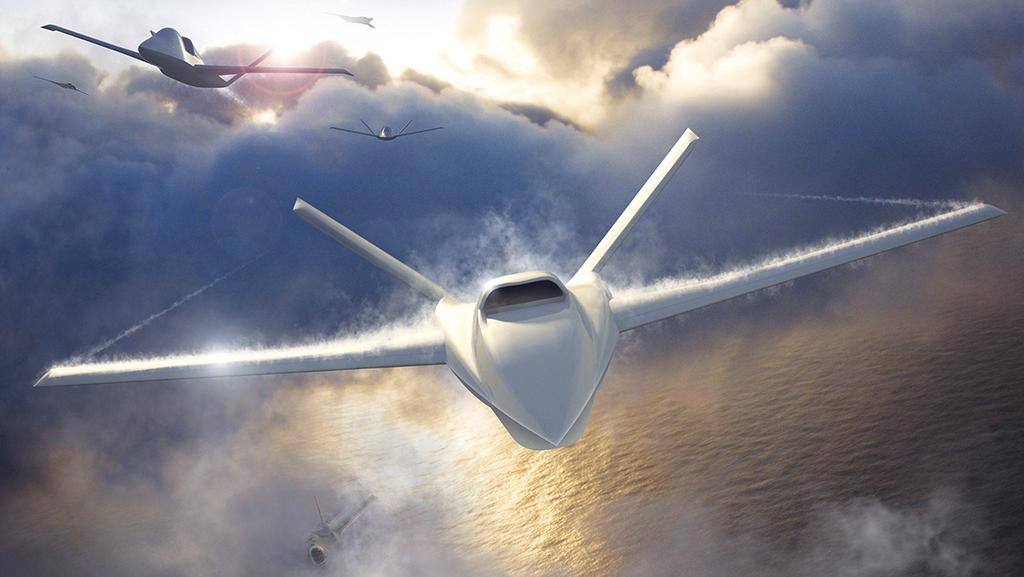
Northrop Grumman unveiled the Model 437 concept in 2021, promising an FJ44-powered autonomous system for under $6 million.
A future class of collaborative combat aircraft have a publicly released mission as well as a quantity and fielding schedule, yet still little is known about the desired size and performance of these future autonomous warplanes sought by the U.S. Air Force and Navy.
- The thrust range is set at 3,000-8,000 lb.
- The requirement follows a trend of increasing sizes of collaborative combat aircraft designs
The prolonged ambiguity over requirements lends significance to the appearance of any new detail. The Air Force has now published a suggested thrust range for the family of collaborative combat aircraft (CCA). If it emerges into a firm requirement, the range points to aircraft types that may be larger and more powerful than the two industry-built demonstrators that have flown to date: the Boeing MQ-28 Ghost Bat and Kratos XQ-58 Valkyrie.
The newly released range of 3,000-8,000 lb. of thrust for the aircraft engine instead follows a trend of CCA designs released since the unveiling of the MQ-28 and XQ-58 before 2020.
An engine delivering at least 3,000 lb. of thrust represents a common thread among the several designs in various stages of design or development, including the Northrop Grumman Model 437, the General Atomics Aeronautical Systems Inc. (GA-ASI) air-launched LongShot, a combat version of the Sierra Technical Services Fifth-Generation Aerial Target and Anduril’s newly acquired Fury. GA-ASI also has released a proposal for a multimission family of Gambit CCAs, apparently derived from the Air Force Research Laboratory’s Off-Board Sensing Station.
By contrast, the sole engine of the MQ-28 demonstrator jointly funded by Boeing and Australia produces about 2,000 lb. of thrust, Aviation Week reported after its rollout in February 2019. Kratos also lists the slightly smaller XQ-58 with an unidentified turbofan in the 2,000-lb.-thrust class.
The Air Force has decided, however, that the future CCAs will need up to four times more engine thrust, according to the market survey released to industry on Sept. 29.
The schedule for fielding the first increment of CCAs does not offer industry much time to design a new aircraft from scratch. The first aircraft should be delivered within three years of a planned CCA program launch in the first quarter of fiscal 2025, which begins next October. Subsequent increments of different CCAs are then scheduled to be delivered in two-year intervals, starting in fiscal 2030.
“For these intervals, the government questions seek information on: capability versus cost; schedule; and risk centered on off-the-shelf, modified off-the-shelf, derivative and new engine designs,” the market survey notice states.
Off-the-shelf options in the Air Force’s desired thrust range include the Honeywell TFE731 and F124, Pratt & Whitney Canada PW300 and PW500, Rolls-Royce AE3007 and the Williams International FJ44.
Those engines power a broad spectrum of single-engine aircraft, ranging from the 12,800-lb. Aero Vodochody L-39 training jet to the 33,000-lb. Northrop Grumman RQ-4 Global Hawk.
The unclassified version of the request for information describes a general list of “desired aircraft characteristics,” but the document does not provide a baseline for comparison. The description instead calls for engines with “increased range, reduced runway takeoff distance, increased Mach capability, increased power and thermal capacity and increased payload.”
As the Air Force’s appetite grows for CCAs with more range, speed and payload, the pressure also will increase on cost. The Air Force no longer defines the attritable quality for CCAs as less than $20 million each. Instead, the Air Force describes attritable as an aircraft that lacks a human crew on board. But officials also are clear that such aircraft must be affordable enough to be acquired in volumes of 1,000 or more.
Industry marketers have been careful to promise more capability but not substantially more cost. When Northrop unveiled the Model 437 two years ago as an uncrewed derivative of the Model 401 Sierra, company officials estimated that the unit cost could stay below $6 million. If realized, the Model 437 could be sold at the same price as Kratos now estimates for the smaller XQ-58 yet offer the capability to carry two Raytheon AIM-120 advanced medium-range, air-to-air missiles internally.






Comments